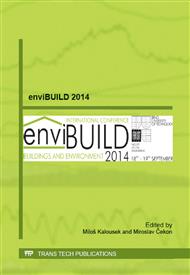p.253
p.257
p.261
p.265
p.269
p.273
p.277
p.281
p.288
Hygrothermal Loads of Building Components in Bathroom of Dwellings
Abstract:
The paper presents an analysis of indoor temperature and relative humidity measurements in dwelling's bathroom. Obtained data are compared with those defined in technical standards and applied for assessment of building component from building physics point of view. These parameters are used for boundary condition at the evaluation level of building components and their values have significant influence on hygrothermal assessment. The example of building's component demonstrates analysis magnitude of differences between the calculation results applying standardized boundaries condition and monitored data based on in-situ measurements. Temperature and humidity measurements are applied for prediction of hygrothermal behavior of building’s component by HAM algorithm. Finally, results from analysis presents the penetration depth of moisture increasing at surface caused by moisture peaks in internal environment of bathroom.
Info:
Periodical:
Pages:
269-272
Citation:
Online since:
October 2014
Authors:
Keywords:
Price:
Сopyright:
© 2014 Trans Tech Publications Ltd. All Rights Reserved
Share:
Citation:


